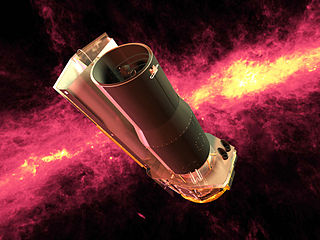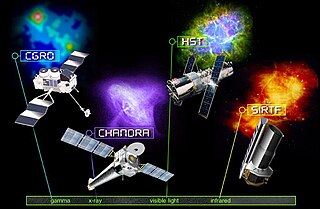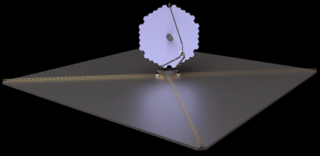Infrared astronomy is a sub-discipline of astronomy which specializes in the observation and analysis of astronomical objects using infrared (IR) radiation. The wavelength of infrared light ranges from 0.75 to 300 micrometers, and falls in between visible radiation, which ranges from 380 to 750 nanometers, and submillimeter waves.

The Terrestrial Planet Finder (TPF) was a proposed project by NASA to construct a system of space telescopes for detecting extrasolar terrestrial planets. TPF was postponed several times and finally cancelled in 2011. There were two telescope systems under consideration, the TPF-I, which had several small telescopes, and TPF-C, which used one large telescope.

The W. M. Keck Observatory is an astronomical observatory with two telescopes at an elevation of 4,145 meters (13,600 ft) near the summit of Mauna Kea in the U.S. state of Hawaii. Both telescopes have 10 m (33 ft) aperture primary mirrors, and when completed in 1993 and 1996 were the largest optical reflecting telescopes in the world. They are currently the 3rd and 4th largest.

The Spitzer Space Telescope, formerly the Space Infrared Telescope Facility (SIRTF), was an infrared space telescope launched in 2003. Operations ended on 30 January 2020. Spitzer was the third space telescope dedicated to infrared astronomy, following IRAS (1983) and ISO (1995–1998). It was the first spacecraft to use an Earth-trailing orbit, later used by the Kepler planet-finder.

The Space Interferometry Mission, or SIM, also known as SIM Lite, was a planned space telescope proposed by the U.S. National Aeronautics and Space Administration (NASA), in conjunction with contractor Northrop Grumman. One of the main goals of the mission was the hunt for Earth-sized planets orbiting in the habitable zones of nearby stars other than the Sun. SIM was postponed several times and finally cancelled in 2010. In addition to detecting extrasolar planets, SIM would have helped astronomers construct a map of the Milky Way galaxy. Other important tasks would have included collecting data to help pinpoint stellar masses for specific types of stars, assisting in the determination of the spatial distribution of dark matter in the Milky Way and in the local group of galaxies and using the gravitational microlensing effect to measure the mass of stars. The spacecraft would have used optical interferometry to accomplish these and other scientific goals.

NASA's series of Great Observatories satellites are four large, powerful space-based astronomical telescopes launched between 1990 and 2003. They were built with different technology to examine specific wavelength/energy regions of the electromagnetic spectrum: gamma rays, X-rays, visible and ultraviolet light, and infrared light.

A coronagraph is a telescopic attachment designed to block out the direct light from a star or other bright object so that nearby objects – which otherwise would be hidden in the object's bright glare – can be resolved. Most coronagraphs are intended to view the corona of the Sun, but a new class of conceptually similar instruments are being used to find extrasolar planets and circumstellar disks around nearby stars as well as host galaxies in quasars and other similar objects with active galactic nuclei (AGN).
Darwin was a suggested ESA Cornerstone mission which would have involved a constellation of four to nine spacecraft designed to directly detect Earth-like planets orbiting nearby stars and search for evidence of life on these planets. The most recent design envisaged three free-flying space telescopes, each three to four metres in diameter, flying in formation as an astronomical interferometer. These telescopes were to redirect light from distant stars and planets to a fourth spacecraft, which would have contained the beam combiner, spectrometers, and cameras for the interferometer array, and which would have also acted as a communications hub. There was also an earlier design, called the "Robin Laurance configuration," which included six 1.5 metre telescopes, a beam combiner spacecraft, and a separate power and communications spacecraft.

Submillimetre astronomy or submillimeter astronomy is the branch of observational astronomy that is conducted at submillimetre wavelengths of the electromagnetic spectrum. Astronomers place the submillimetre waveband between the far-infrared and microwave wavebands, typically taken to be between a few hundred micrometres and a millimetre. It is still common in submillimetre astronomy to quote wavelengths in 'microns', the old name for micrometre.
The Beyond Einstein program is a NASA project designed to explore the limits of General theory of Relativity of Albert Einstein. The project includes two space observatories, and several observational cosmology probes. The program culminates with the Einstein Vision probes, after completion of the Great Observatories program.
A nuller is an optical tool used to block a strong source so that fainter signals near that source can be observed. An example of a nuller is being employed on the Keck Interferometer. This causes the light from a star to destructively interfere, effectively cancelling the star's image. As a result, the faint light from a ring of dust orbiting the star can then be detected. This project is part of a scientific effort to detect and observe nearby planets.
The Navigator Program is a long-term NASA project charged with over-seeing all missions related to the detection and characterization of Earth-like planets. It also seeks to further understand how galaxies, stars, and planets form. Navigator, with a 25-year time window, is essentially an umbrella program for more specific current and proposed projects which seek out Earth analogues and possible extraterrestrial life. The main components of Navigator include two ground-based and two space based missions.
PlanetQuest is NASA's education and public outreach program centered on the science and technology of NASA's long-term search for habitable planets beyond the Solar System.

Multiple satellite imaging is the process of using multiple satellites to gather more information than a single satellite so that a better estimate of the desired source is possible. So something that cannot be seen with one telescope might be visible with two or more telescopes.

The NASA Exoplanet Science Institute (NExScI) is part of the Infrared Processing and Analysis Center (IPAC) and is on the campus of the California Institute of Technology (Caltech) in Pasadena, CA. NExScI was formerly known as the Michelson Science Center and before that as the Interferometry Science Center. It was renamed NExScI in the Fall of 2008 to reflect NASA's growing interest in the search for planets outside of the Solar System, also known as exoplanets. The executive director of NExScI is Charles A. Beichman.

The Large Ultraviolet Optical Infrared Surveyor, commonly known as LUVOIR, is a multi-wavelength space telescope concept being developed by NASA under the leadership of a Science and Technology Definition Team. It is one of four large astrophysics space mission concepts studied in preparation for the National Academy of Sciences 2020 Astronomy and Astrophysics Decadal Survey.

Origins Space Telescope (Origins) is a concept study for a far-infrared survey space telescope mission. A preliminary concept in pre-formulation, it was presented to the United States Decadal Survey in 2019 for a possible selection to NASA's large strategic science missions. Origins would provide an array of new tools for studying star formation and the energetics and physical state of the interstellar medium within the Milky Way using infrared radiation and new spectroscopic capabilities.
Cosmic Vision is the third campaign of space science and space exploration missions in the Science Programme of the European Space Agency (ESA). Formulated in 2005 as Cosmic Vision: Space Science for Europe 2015–2025, the campaign succeeded the Horizon 2000 Plus campaign and envisioned a number of missions in the fields of astronomy and solar system exploration beyond 2015. Ten missions across four funding categories are planned to be launched under Cosmic Vision, with the first being CHEOPS in December 2019. A mission to the Galilean moons (JUICE), the first deep space mission with an opportunistic target, and one of the first gravitational-wave space observatories (LISA), are planned for launch as part of the Cosmic Vision campaign.










